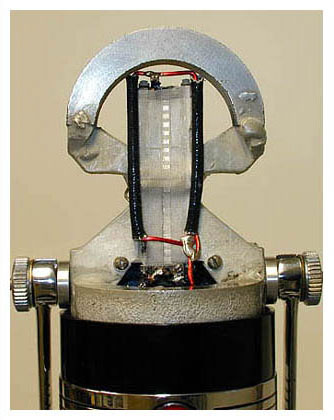Well, I put together a ribbon mic without any pole pieces just to see how well it would work. First crack out of the box wasn't too bad at all! That's something, considering I used a crappy ribbon I had whipped out as a practice piece. It's not totally parallel, but was not too awful. It's also made from capacitor aluminum (I had some brand new stuff) that's about 4-5 microns thick. Too thick, I know, but the sound is better than I had hoped. I'll get a proper aluminum leaf ribbon in there and see what happens.
This is just a test rig, not ever intended to go into a housing or anything. If I can get it sounding good, I'll build another one to put in a nice brass housing. What you see here is:
1/4 inch black plexiglass body with series of 1/2 inch holes.
A slot in the center to accept 2 50mm X 2.5 X 5mm magnets (I used a third magnet with some notecard wrapped around it to give me the spacing I wanted) The magnets are just epoxied in place. The magnets are flush with the front of the plexiglass, as is the ribbon.
The contacts are made from copper clad PC board (one sided) and the wires are soldered to the "back" in the picture. You can also see some 1/4" holes to allow for clearance of the soldered areas.
The trafo is a Lundahl ribbon mic type.
This was all made with simple tools, no milling machine, just a bandsaw, drillpress, and some files.
NOTE TO RIBBON MAKERS: Try one of those "wheel" type cutters used for cutting fabric to cut your ribbons. They look like a small, razor sharp pizza cutter. Works great! I'm still coming up with a good jig to make the ribbons easily, but it will be used with this type of cutter for sure. Pictures of that jig when I have them.
In the meantime, I welcome comments, positive or negative.





